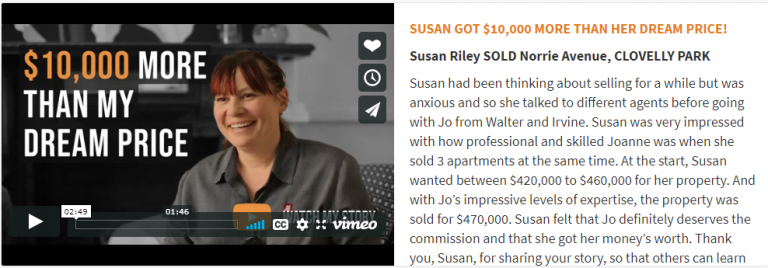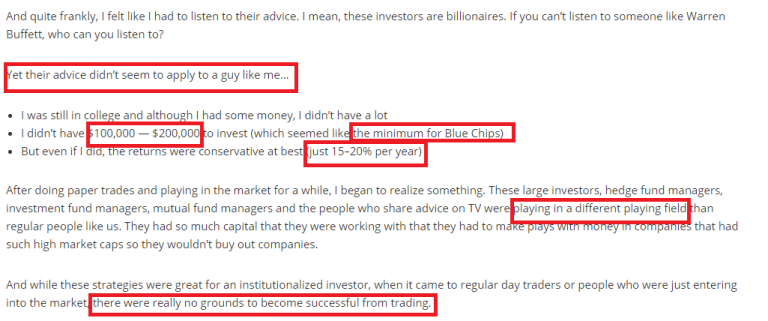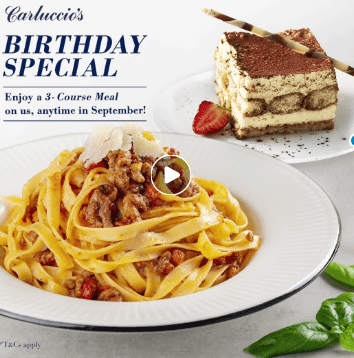Marketing Psychology Principles Explained With Real Examples
Marketing psychology is seen as a cheat code for businesses. But it can be very difficult to implement correctly.
Instead of trying to extensively cover every marketing psychology principle, I’m going to focus on two key overarching concepts.
They are:
- Creating belief and trust in your brand
- Helping consumers save time and mental energy
You will learn the psychological reasons these two things are so important. And then I will give you the psychology principles behind both concepts.
When I was doing my research for this blog post, I checked to see other posts on the topic of marketing psychology. Other posts on the topic cover some important concepts. But they all lack good examples.
This post is going to be backed with real examples so you can see exactly how these principles are actually applied.
By seeing the real-world application of these ideas, it will be much easier for you to use them in your own marketing.
One of the first things you need to understand is how people make decisions.
The Psychology of Decision Making
Humans are irrational.
You might think that consumers will make a carefully weighted decision when deciding between your product and one of a competitor.
But they don’t. People use mental shortcuts to make decisions. These shortcuts allow you to save time and conserve mental energy.
They are known as heuristics. This 4 minute YouTube video explains exactly what heuristics are:
If you understand how these mental shortcuts work, you can use them to your advantage. They will make your marketing 10x more effective.
Heuristics can cause people to make sub-optimal decisions. For example, when a plane crash receives a lot of coverage in the media, people are more likely to drive between cities rather than flying.

But this is actually a bad decision. Because the risk of being killed in a car accident is higher than being killed in a plane crash.
This is explained by the availability heuristic.
The availability heuristic basically means that your mind will place greater emphasis on information that is more conspicuous.
Heuristics create a perception in your mind. Then we make decisions based on those perceptions. In marketing, perception is reality.

We also use associations to form our perceptions.
Associations are formed through culture, experiences, media and advertising. Here are some common associations that you can probably relate to…
Suits are associated with power and authority.
The color green is associated with freshness and the environment.
Glasses are associated with intelligence.
High prices are associated with high quality.
Chinese made is associated with cheap.
These are just a handful of common associations. There are many more. And these associations help form perceptions. Then perceptions inform your decisions.
The lesson to take away from this is that you don’t need the best product or service on the market to get the most sales. By using heuristics and associations, you can control the perception of your brand. And perception is what leads to sales.
Note: I don’t advocate using the psychology principles to sell bad products. It’s unethical and you shouldn’t do it.
In this post, you will discover specific psychology tactics you can use to create a positive perception of your brand.
Controlling The Perception in Your Prospect’s Mind
Another way to think of perception is the conversation occurring in your prospect’s mind.
I got the idea of ‘the conversation in your prospect’s mind’ from Jordan Belfort’s book The Way of The Wolf.
Whenever someone interacts with you or your brand, there is a conversation taking place in their mind. Some of this conversation is conscious but much of it occurs in the subconscious of the mind.
The conversation is largely a result of heuristics (mental shortcuts) and associations.
You want to present your brand in a way that creates a favorable conversation in your prospect’s mind. And this can be achieved by applying marketing psychology principles.
The best way I can explain this is through examples.
Bad Example: Business Coaching Website
I searched on Google for “business coaches Australia.” One of the top results was business coach Donna Stone…

That’s the view on Donna’s business coaching landing page. What’s the conversation occurring in your mind when you see this page?
Personally, I instantly think boring! I imagine Donna would be uninspiring, have outdated information and be difficult to talk to.
If you look at Donna’s website, you will probably begin to form a vision of what working with Donna would be like.
Donna Stone could possibly be an excellent business coach. But because she hasn’t controlled the conversation in my mind in a favorable way, I’m never going to use her services.
My negative perception of Donna’s services came from associations.
The first thing you see on Donna’s website is large blocks of text and long paragraphs. People will generally associate large blocks of text with things like academic papers. And then the vast majority of people will associate academic papers with boring.
It also violates a key principle that I will be discussing much more in this post. That is: people naturally want to conserve time and energy.
There’s a reason why all my paragraphs are short. And why most of my sentences are short as well. When you see long paragraphs, big sentences, and long words, your mind switches off.
Reading these long blocks of text will require too much mental energy. So your brain resists it. But when you see short paragraphs and sentences, it’s easier for your brain to process.
The homepage on Donna’s website is slightly better but she still makes the same mistakes…

Again, we have big, long blocks of text that communicate to her audience that she’s boring.
Donna does have a photo on her homepage. But there are no photos on her consulting page (where Google is sending traffic to). The lack of photo, will subconsciously make the viewer wonder whether they can trust Donna.
The overall design of the website looks outdated. And people will tend to associate old, outdated websites with lower quality.
It’s a shame because Donna is probably getting a lot of traffic coming from Google since she’s ranked so highly for the term “business coaches Australia.” But she could be getting so much more business if she better understood marketing psychology.
Good Example: Life & Business Coach
Here is an example of a life and business coach from Canada, who is controlling the conversation in a positive way.

This is the homepage of Canadian life coach Lisa Jeffs. She’s doing a lot of things right to control the mental conversation.
The “As Seen In” section tells the viewer, that she is an authority and someone worth listening to. This is a concept known as ‘authority by association.’ And I go into more detail on this soon.
She has a great photo that communicates a lot to the viewer. Her body language signals to the viewer that she is approachable and friendly but very sharp and switched on. The viewer is already forming a vision of what she would be like to work with.
If you scroll down, you notice that she uses nice short paragraphs and sentences…
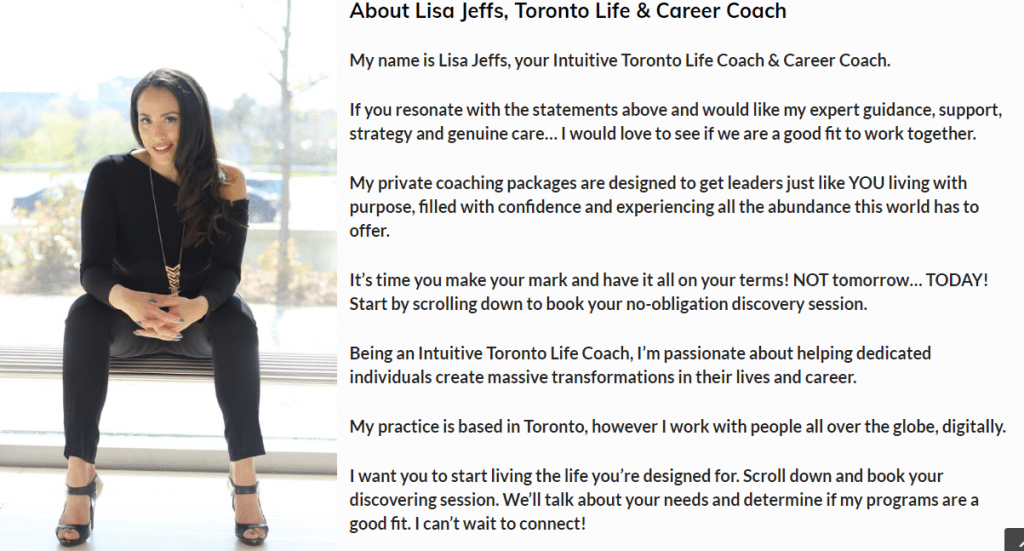
Her style of writing and language used communicates to the viewer that she’s a professional but she’s also a regular person.
Even the color scheme helps to create a favorable perception in the minds of her audience. The yellow is associated with warmth, happiness and optimism. While the black is associated with power and sophistication.
This article from HubSpot goes into more detail on the psychology of colors in marketing.
How To Make Customers Believe & Trust You
You could have a product that produces life changing results. But if people don’t believe or trust you and the product, they won’t buy.
Fortunately, there are various marketing psychology triggers you can use to gain belief and trust. Applying these principles that I’m about to describe, will help to…
- Develop a perception of credibility
- Gain trust
- Increase the perceived value of your product(s)
Authority Bias
If you’re selling expertise or information, this is one of the most powerful marketing psychology techniques you can use.
People have an auto-pilot response to believe and trust those who are seen as authorities. This is one of the mental shortcuts that people use to form opinions and make decisions:
Authority = reliable, trustworthy source of information.
You don’t even need to be an authority yourself. Just by associating yourself with figures or authority, you can benefit from the psychological power of authority.
Experts, coaches, writers will often include a ‘featured in’ section on the home page of their website to leverage the power of authority. The example below is from the website of health and wellness writer Kelly LeVeque.

When you connect yourself with figures of authority, their credibility is carried over to you. This is why celebrity endorsements are so powerful.
The screenshot below from the website of writer and speaker Mona Dixon is a great example of this. It’s a photo of her with former President Barack Obama. She also has photos of herself with other celebrities including Jennifer Lopez and LeBron James.
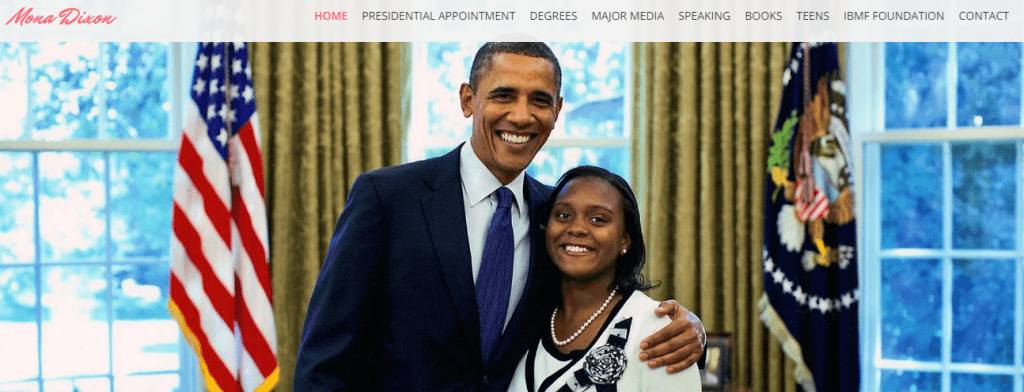
If you want to learn more about the power of authority in marketing, I suggest reading my analysis of JT Foxx’s seminars.
Wealth and business coach JT Foxx, leverages authority better than anyone I’ve seen before. Everything from the clothing he wears, his vocal tonality and stories he tells. It’s all orchestrated to develop a perception of authority.
Authority bias is just one psychological tactic that can create a perception of credibility, leading to trust. But there are other marketing psychology techniques you can use to create a similar effect.
The Length Implies Strength Heuristic
The message length heuristic (mental shortcut) is a simple way to add more (perceived) credibility to your marketing messages.
Longer messages containing a lot of information and facts are more persuasive simply because of their length. People subconsciously think to themselves “there is a lot of information here, so it must be good.”
Mere Exposure Effect
This is another heuristic known as the familiarity heuristic. People have a natural tendency to trust and favor that which is familiar to them.
So just through mere exposure, you can create a perception of credibility. You can benefit from the mere exposure effect by using retargeting advertising.
I write in more depth about the mere exposure effect in my article on Kerwin Rae.

Vocal Tonality
People in positions of authority will generally speak with conviction. They sound very sure of themselves.
Take this example from the TV show Suits. Pay attention to Harvey Spector’s vocal tonality.
Even if you don’t know anything about Harvey Spector’s character, you will automatically perceive him as an authority because he speaks with such conviction.
This is because people have learned to associate a strong and confident vocal tonality with credibility and competency.
If you use video marketing in your business, you can create a perception of credibility by speaking with conviction in your videos.
Credibility Through Pricing
Consider the following two products. Both are 100ml aftershave lotions sold on Amazon.


Which of the two products do you perceive as higher quality?
Most people will say the Yves Saint Laurent Kouros After Shave. And there are a number of psychological factors that create this perception.
The packaging design conveys quality. The ratings create social proof. And primarily, the pricing.
People automatically associate higher price with higher quality. By pricing your product at a high price point, you can create a perception of quality and credibility.
Social Proof
Which of the following Italian restaurants in Singapore would you rather eat at?


Based on the information available, you will almost certainly choose Positano Risto.
Positano Risto has a 4.5 star rating from 1,011 reviews, while Al Capone’s has just a 2.5 star rating from only 14 reviews. So you automatically assume that Positano Risto will have better food.
People tend to use other people’s opinions as a mental shortcut for making decisions. You can use this to your advantage by getting positive reviews, testimonials, more social media followers and more people in your store.
Help People Save Time and Mental Energy
Your brain is programmed to want to conserve time and mental energy.
This article from Big Think explains the evolutionary reason why our brains are wired to conserve energy.
If you want people to take an action, you have to make it easy for them. I’m not just talking about purchases, I mean any action. That includes…
- Booking a consultation
- Reading an article
- Watching a video
- Sharing a testimonial
- Completing a survey
The less mental energy required, the better.
Appeal To Desire For Ease & Simplicity
People will do whatever they can to avoid effort. The easier you make it for people to do business with you, the more sales you will get.
If your product or service offers a specific outcome (such as weight loss), create a perception that the outcome is easy to attain. As long as they use your product.
Good Example: Free Trial, No Credit Card Required
Firstly, let’s look at a good example of making it easy to buy from you.

This is the free trial sign-up page for social media scheduling tool, Loomly.
Firstly they offer a 15 day trial. This is smart because it appeals to the loss aversion bias – an important marketing psychology principle that I will discuss more in this article.
But they also emphasize that no credit card is required and there is no obligation. And registration for the free trial requires nothing more than a name, email and password.
People will often resist even free trials if they have to enter their credit card details. Entering your credit card details takes time.
And you know if you want to cancel before the end of the trial, you will have to login to the website and find the option to cancel to avoid being charged.
Good Example: Anytime Fitness
In the screenshot below, you see just how easy it is to get started with Anytime Fitness. All you need to do is provide your name, email and phone number:

This free trial offer is very easy to find on their website. The full process of beginning a gym membership with Anytime Fitness does indeed require a lot more effort.
But they give you the perception that it’s actually simple. This is known as the foot in the door technique. This is a concept I will shortly discuss in more depth.
Bad Example: Local Gym
I searched on Google for local gyms and found Bulldog Gym Brisbane:

Firstly, any local business needs to have a phone number and address clearly visible at the top of the website. Searching for these essential details requires mental effort, which people will naturally resist.
Unlike Anytime Fitness, Bulldog Gym Brisbane don’t make it easy for new members to get started with them. There is no prominent ‘Start Your Free Trial‘ or ‘Get Started Now‘ button.
The membership button does take you to a page explaining membership options and allows you to fill out a registration form.
But they are asking the potential member to exert far too much time and mental energy to get started.
Solve Your Customer’s Problems With Ease
Does your product or service offer a specific outcome for your customers?
For example.. better health, financial independence, better appearance, more success, security, more sales.
You want to create a perception that your product will deliver that outcome fast and with ease.
Of course, you should not promise something you cannot deliver on. You don’t want to be offering get rich quick schemes.
We live in an instant gratification society. Consumers want outcomes now. And they want it to be easy. This article from Psychology Today explains the psychological reasons people desire instant gratification.
Weight loss companies are known to exploit this desire for ease and fast results…

The ad above tells the audience they can achieve rapid results. They also give signal to their audience that results will come with ease:
“Our rapid results program leverages innovative science involving the circadian rhythm which was awarded the 2017 Nobel Prize in Medicine.”
A lot of people will associate ‘innovative science‘ with ‘shortcuts‘. And then they associate ‘shortcuts‘ with ‘ease.’ They also leverage authority bias by referencing the Nobel Prize in Medicine.
In another article, I explain how online marketing guru Alex Becker appeals to the desire for ease in his Shopify webinar.

In that article, I explain in detail the marketing psychology tactics that Becker uses in his webinar. I explain how each of those words and phrases highlighted above has specific psychological associations. These associations create a perception of ease.
The Foot In The Door Technique
I once attended what I thought was a job interview for a health club manager position.
What I discovered was that it was really just a presentation to get people into a course they were offering. The course was designed to train people on how to manage a health club, with the hope that those people would someday become franchisees of the health club.
It was actually a very clever strategy.
At the end of the interview/presentation, they asked me if I had anything planned for that night. They continued to tell me they were starting the course at 6pm that same day and invited me to come along to see what it was like.
Going along to the first night of this course seemed pretty harmless. There was no cost. It was just two hours. And if I didn’t like it, I wouldn’t have to go back.
I had fallen victim to the foot in the door technique.
The next thing I knew, I was committed to an 8 week course. That involved attending 4x two-hour classes every week. 5-10 hours of practical training every week. And homework assignments.
If they had asked me at first if I wanted to start a course that would require 20-30 hours of my time every week, I almost certainly would have said no.
But instead, they got me to commit to something that required far less time and mental energy. Once I had made that first commitment, it was much harder for me to say no to their next request.
The screenshot below is from the website of men’s hair restoration clinic Ashley & Martin.

Their product requires a large financial, mental and time commitment from customers. But by using the foot in the door technique, Ashley & Martin are able to increase the chances someone will make that commitment.
The foot in the door technique also activates what is known as the commitment and consistency bias. This is a tendency people have to act in a way that is consistent with actions they have already taken.
Position Yourself As ‘The One’
This is one of the most powerful marketing psychology tips that almost nobody talks about.
People are sick of searching. They’re sick of being disappointed. They’re sick of not getting what they want.
Even if they haven’t been searching for long, they don’t want to. Searching takes time, mental energy and could result in disappointment.
People delight in finding “the one” because they can call off the search. It’s a weight off their shoulders. They don’t have to continue spending mental energy on searcing.
Everyone wants “the one.” It could be “the one course” that will teach them everything they need to know about real estate.
Or “the one person” (their soulmate) that will make them happy. They want “the one coach” who will be able to teach them everything they need to know.
They want “the one house” that has everything they’re looking for.
If you can position yourself or your brand as “the one,” then your offer will be extremely persuasive on a psychological level.
Look at how these products are positioned as “the one.”
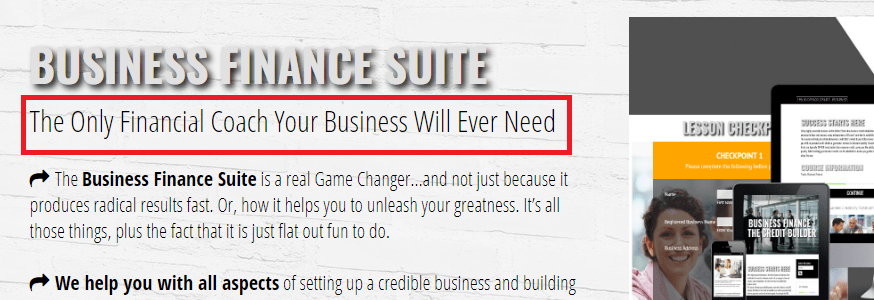

This is one of the main tactics used by ClickFunnels founder Russell Brunson to sell $3.2 million in one single presentation. He tells the audience that ClickFunnels is the one software they need in their businesses.
I explain this in more detail in my analysis of Russell Brunson’s presentation. You will see exactly how he positions ClickFunnels as the one.
How To Position Your Brand As The One
Positioning yourself is not as hard as you may think. As Jim Davies explains in his book Riveted, people have a tendency to believe things that they hope to be true.
People want to believe that your product or service is the one. They will be delighted to discover that out of all the options available, they have found the best.
Specific Headlines You Can Copy
There are certain phrases you can use in your headlines or ad copy to leverage “the one effect.” These are some examples…
“The Only Forex Trading Video You Will Ever Need”
“Finally! A Weight Loss Pill That Actually Works”
“You Will Never Need To Read Another Sales Book”
“The Only Pizza Restaurant in Sydney That Makes Authentic, Traditional Italian Pizzas”
“A Financial Adviser You Can Finally Trust”
“The One Tip That Will Transform Your Dating Life”
Each of these headlines will signal to the reader that ‘this is it!‘
“This is the one!”
Using phrases like “the secret to” or “the little known truth” or “nobody is talking about this” can have the same effect. Each of these subtly communicates that you are the one with something valuable that nobody else has.
Discrediting Your Competitors
A simple and effective way to position yourself as the one is by showing why your competitors have got it wrong and you’ve got it right.
Here are a few examples…

This Facebook ad is from Australia’s fastest growing digital agency, King Kong.
Firstly they say “the entire marketplace is bombarded with messages telling you to do 1-million and one things like; Snapchat, Twitter, Facebook Live, Public Speaking, Content marketing, YouTube and Networking.”
The implication here is that “this is what the competition are saying…and they’re wrong.”
And that implication is something that people hope to be true. As I said earlier, people are more likely to accept that which they hope to be true.
People don’t want to do all those things. They want an easier alternative. And it seems like King Kong might have that.
Then they continue to say “none of these things matter unless you nail these two fundamental areas.”
They have now discredited their competitors who are telling people to do all these other things. And positioned themselves as “the one” who has the real solution.
One of the best examples I have seen is from business coach Brett McFall…
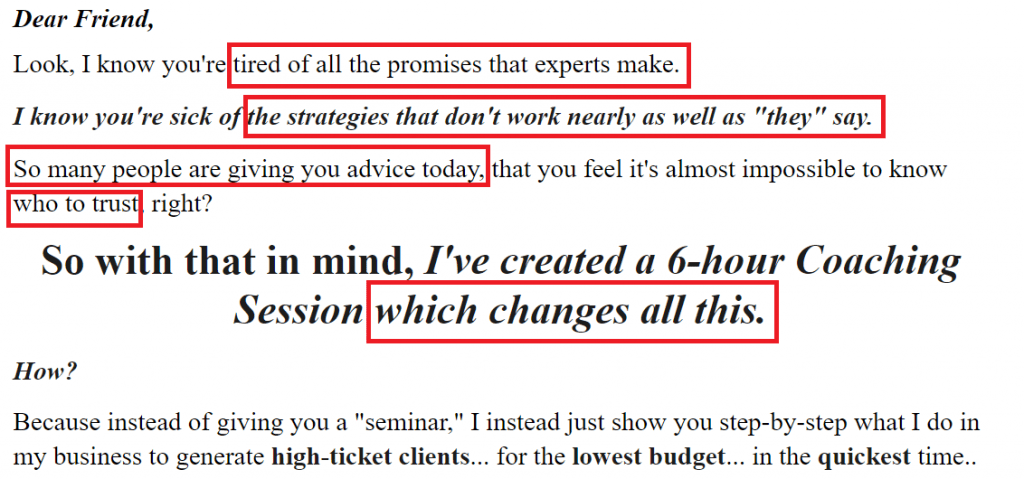
This screenshot is from Brett McFall’s landing page. You see the language he uses to discredit his competitors and position himself as the one.
By using words like secret and formula he creates the perception that he has something unique, which his competitors don’t have:

Establishing a strong USP (Unique Selling Proposition) will also help to position you as the one over your competitors.
Summary
I could go on and on with different marketing psychology principles.
And if you read some of my other blog posts, you can learn about other concepts too.
But focusing on these principles I’ve presented here is going to take you a long way. These are the fundamental marketing psychology principles being used by the world’s top brands.
In the digital marketing world right now, everyone is focused on things like conversion rate optimization, A/B testing, funnels and email. But if you can start using heuristics and associations to your advantage, your competitors won’t be able to keep up with you.
To learn more about marketing psychology, I suggest reading Influence by Robert Cialdini and Cashvertising by Drew Whitman.


